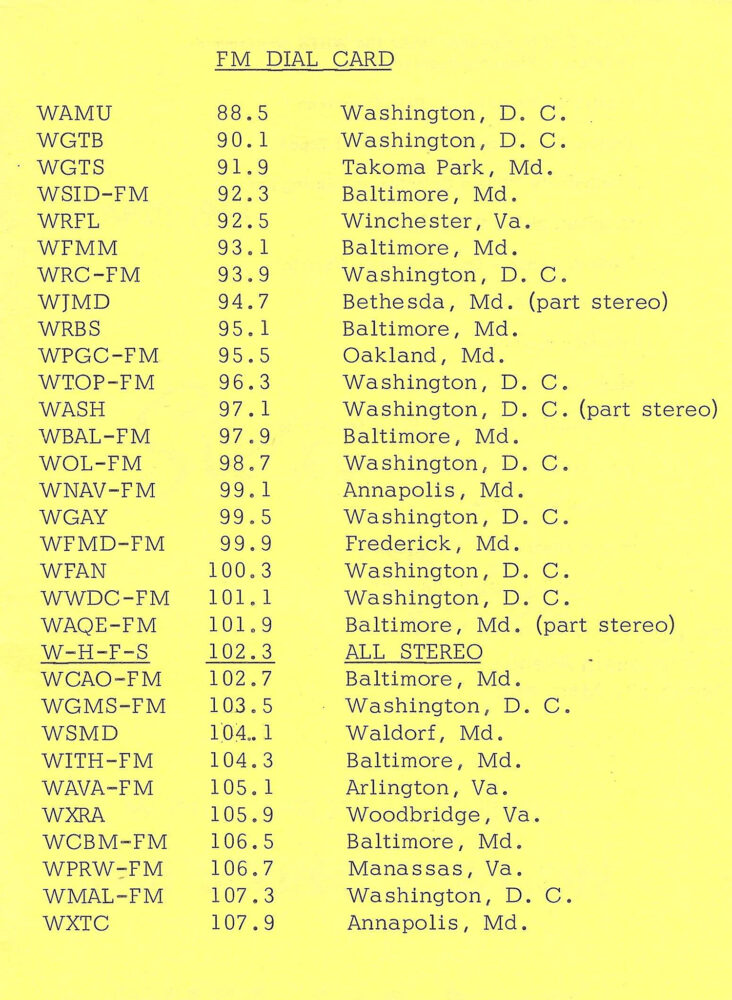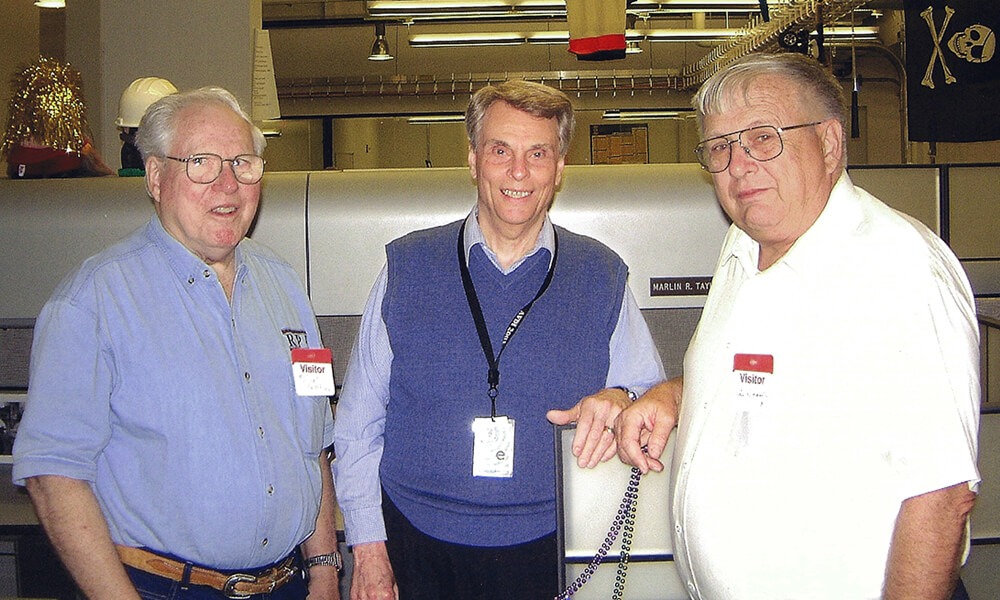. . . and its two founders!
Updated from the original post dated 9/13/18.
The story of this station’s birth, which occurred in the early 1960’s, is more like ones from radio’s pioneering days of the 1920’s and early 30’s than from the industry’s modern era following The Second World War. And I was privileged to play a small role … to program and operate the station.
Even though I share a fair amount in my memoir, with the passing in early August of the second of the two partners — William A. Tynan at age 91 — who with Robert J. Carpenter founded the station in 1961 … I feel a need to go a little deeper into the story of how it all began, as told in their own words.
First … who were Bill and Bob? Plain and simple, they were two gentlemen who had obtained engineering degrees, had met through their mutual interest and activity in amateur (“ham”) radio circles as well as an interest in radio broadcasting.
Bill Tynan writes in his autobiography:
“About 1959, Bob Carpenter and I began talking about putting on a station. We studied the rules, looked for potential locations and began preparing an application. We were confident we could do all of the engineering work ourselves, which we did.”
Bob Carpenter picks up:
“By this time it had become obvious that the last unoccupied FM channels in major cities would soon be gone. So we applied for the last unoccupied FM channel in the Washington, DC, area – 102.3 MHz, a Class A (low power) channel allocated to the suburb of Bethesda, Maryland.
On July 21, 1960, the FCC granted us a CP for the station – we chose the call WHFS, Washington’s High Fidelity Station – and our wild ride began.
Both of us kept our day jobs since it was clear that a small FM station could not afford us.
Of course, as we had ordinary engineering jobs and not much money in the bank, it was not like we could afford to go out and purchase a “real” transmitter or studio equipment. So we did what we could do … we improvised. Like many others of his age, Bill had worked part-time minding the transmitter at WASH-FM, located in nearby Wheaton, and thus knew Everett Dillard, the station’s owner.”
Bill Tynan:
“Mr. Dillard had, in the back room, a big grey box which he had received from Major Edwin H. Armstrong, the inventor of FM. It had been employed by WASH prior to Dillard acquiring a 5 kilowatt RCA transmitter. Mr. Dillard had later replaced the exciter from the RCA transmitter as well. So, I negotiated with Mr. Dillard to buy the big grey box AND the RCA exciter. I think we paid about $1,000.
In June, 1961, FCC came out with their stereo rules. Bob and I were well on our way to assembling equipment, and decided we had to hit the air with stereo. If we could be first in the Washington area with this new type of broadcasting, it should give us a leg up.”
Bob Carpenter:
“For us, that was our chance to stand out – we would be Washington’s first FM Stereo station. But commercial stereo transmitting gear was not yet available and we could not afford it anyway.

We learned that CHFI in Toronto had an RCA exciter like ours and fed composite stereo to it from an H. H. Scott stereo test generator. So, we bought a Scott unit and I interfaced it to the RCA exciter. I also built a solid-state studio control console with four stereo input channels.
WHFS went on the air on Sunday, November 12, 1961, from a 20 x 20 foot area in the basement of the Bethesda Medical Building. We only operated afternoons and evenings. But we were Washington’s High Fidelity Stereo station.
In 1962 we got a phone call from someone at the Federal Communications Commission, saying they had a delegation from the Japan Broadcasting Company and would like to have them visit a ‘real’ American FM Stereo station. They must have been appalled with our shoe-string operation, but were very polite.”
In an article written by Bob on the occasion of the 50th anniversary of the station’s birth — from which the above has been adapted — the headline read: FM Stereo on a Shoestring! I estimate that WHFS was built and placed in operation for less than $5,000.00.
In the above, Bob spoke of keeping their “day jobs,” which were for Bill, being affiliated with API, The Applied Physics Laboratory of Johns Hopkins University, while Bob was at the U. S. government’s National Bureau of Standards, which today is known as NIST, the National Institute of Standards and Technology.
It was Bob who literally built the station by himself, piece by piece. As I wrote in my memoir:
“… a fair amount of it was being built by him from scratch, including the control console and portions of the transmitting system. As I commented at his memorial service, Bob began his endeavor with not much more than a pile of junk radio equipment and a box of electronic parts.”
I owe a great deal to Bill and Bob and am most thankful for their being willing to put their trust in this young guy who had little real radio experience. If they hadn’t, where might I be today? This position became the giant stepping stone I needed, as it gave WDVR owner Dave Kurtz the confidence to hire me–Dave was an engineer as was Bill and Bob, and I had been involved from the beginning of getting their new radio station up and running and managing its daily operation.
As for WHFS’s programming … Fortunately, I had been blessed with the intuitive sense to be able to program the various genres of music which they had decided the station should air. We played mostly classical, but had specialty programs of ping-pong recordings, comedy albums and Broadway and Dixieland music.
It was a demanding position, but I loved every minute of it. Not only did I continually need to search for and acquire new recordings, and choose and pre-schedule the selections heard in most hours, I also operated the station from 4 P. M. (later 12 Noon) sign on ‘til something like 8 P. M. Monday through Friday. By the summer of 1962, we determined that it’d be beneficial to offer listeners a monthly program guide to which they could subscribe for the magnanimous sum of something like $2.00 a year. This called for planning the programming even further ahead and being sensitive to the calendar, holidays and seasons calling for special attention.
In the back of each Stereo Notes issue we included this listing of all the FM stations operating in the greater Washington-Baltimore area … likely the first time a station ever published or printed such a listing––no radio station manager in his right mind, whether they offered a program guide or not, would ever think of distributing something that included all of their competitors call letters and frequencies.

While my stay at WHFS was a little short of two years, it was the launch pad for my move to Philadelphia … where my broadcast career truly began to flourish.
Meanwhile, the “legendary” part of WHFS’s history was yet to be written — that period would not begin until nearly five years after I had departed and Bill and Bob had sold the station. While they had chosen to air a “potpourri” mix of genres and the intervening years offered who-knows-what, it was the genre known as “free-form progressive rock” hosted by personalities with names like Weasel, Cerphe, and Damian which put the station on the map.
Now, a gentleman named Jay Schlossberg, who was a big fan of WHFS during its glory years, has set out to tell the station’s story right from its pioneering beginnings through a documentary film titled, Feast Your Ears: The Story of WHFS 102.3.
While the completion of production has run behind schedule for a variety of reason including the pandemic, Jay is committed to it being finalized here in early 2021. Then, it’s the matter of who will handle distribution so you and all can experience this great broadcast story. For updates and to be part of the excitement, visit the Film’s website at FeastYourEarsTheFilm.com!
There are those who likely think — considering the 1946 AM-only radio which appears on the cover of my memoir and from judging what appears on this page week after week — I am stuck in the past. Not true … but I subscribe to the thinking behind this Broadcast Pioneers of Philadelphia saying … “it’s only history if it gets saved/ preserved.” That’s why I write … I am an historian at heart! Meanwhile … what’s your story? How about sharing it and sending it to me?
Image Credits: Bill Tynan (on left) and Bob Carpenter (right) visit Marlin at XM Satellite Radio in 2002.









Marlin, was the original WHFS antenna on top of the apartment building in Bethesda, where the antenna was in the later years?
Roddy, the original antenna location was a short tower on a two-story building in the middle of Bethesda, which really limited our coverage. Bill and Bob sought to make a deal for a spot on a building in Northwest Washington near the original WTOP-TV location … the cost proved to be too costly. At the time, the apartment high-rises did not exist … they came a few years later, and the top of one of those would become the station’s home – after all three of us had departed the station.
Today, I believe the 102.3 transmitter is on the American University tower in Washington, which is not far from the WTOP-TV side off Wisconsin Avenue.
Thanks, Marlin. I continue to enjoy your posts.